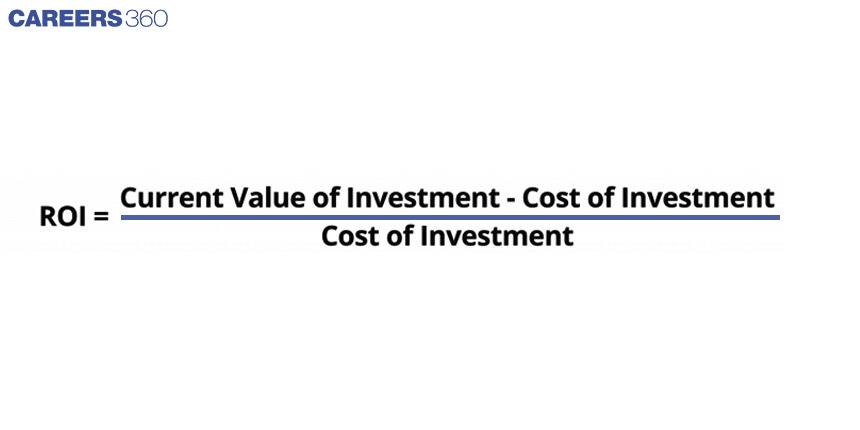IMI Bhubaneswar PGDM Admissions 2026
Phase 02 Applications Window Closing on 23rd January 2026 | 100% Placements Record | Highest CTC 40.31 LPA | Average CTC 12.74 LPA | Median CTC 12.48 LPA
One common aspect that is considered when people contemplate on and evaluate MBA programs is the Return on Investment (ROI), the reason simply being that an MBA or PGDM is an expensive programme. Also, the fee and costs associated with MBA programmes are increasing at an exponential rate.

Let us first understand what ROI is. According to Investopedia, ROI is a performance measure used to evaluate the efficiency or profitability of an investment or compare the efficiency of a number of different investments.

The investment/cost of an MBA program typically comprises the following components:-
One should ideally take the following factors into consideration while calculating the financial ROI of an MBA programme:-
Also Read | Can I Do An MBA After Class 12?
The table below shows the fees and initial salaries offered by some of the leading MBA colleges in India. However, while reading through the table, a few points may be kept in view:-
Also Read | Careers In Commerce That Did Not Exist 10 years ago
Name of MBA College | Fee | Initial CTC - Median Salary | Payback period | Source | ||||
Year | Amount (Rs/ Lakhs) | Year | Amount (Rs/ Lakhs) | Number of months | ||||
IIM Ahmedabad | 2021-23 | 23.00 | 2021 | 24.50 | 11.27 | www.iima.ac.in | ||
IIM Bangalore | 2021-23 | 24.50 | 2021 | 28.60 | 10.28 | www.iimb.ac.in | ||
ISB, Hyderabad* (Fees - Rs 36.50 lakhs) | 2022-23 | 16.25 | 2021 | 27.00 | 7.22 | www.isb.edu | ||
IIM Lucknow | 2021-23 | 19.25 | 2022 | 29.00 | 7.97 | www.iiml.ac.in | ||
XLRI Jamshedpur | 20.50 | 2022 | 30.00 | 8.20 | www.xlri.ac.in | |||
SP Jain Institute of Management & Research | 2021-23 | 19.00 | 2022 | 30.10 | 7.57 | www.spjimr.org | ||
IIM Indore | 2022-24 | 21.24 | 2021 | 22.60 | 11.28 | www.iimidr.ac.in | ||
IIM Kozhikode | N.A. | 20.50 | 2022 | 26.50 | 9.28 | www.iimk.ac.in | ||
FMS, Delhi University | N.A. | 2.00 | 2022 | 32.40 | 0.74 | |||
MDI Gurgaon | 2021-23 | 16.00 | 2022 | 23.50 | 8.17 | www.mdi.ac.in | ||
IIFT, New Delhi | 2021-23 | 21.48 | 24.00 | 10.74 | www.iift.ac.in | |||
Jamnalal Bajaj Institute of Management Studies | N.A. | 6.00 | 2022 | 26.48 | 2.72 | www.jbims.edu | ||
IIM Rohtak | 2022-24 | 17.90 | 2022 | 15.00 | 14.32 | www.iimrohtak.ac.in | ||
IIM Jammu | N.A. | 15.55 | 2022 | 12.75 | 14.64 | www.iimj.ac.in | ||
IIM Udaipur | 2022-24 | 13.10 | 2022 | 15.60 | 10.08 | www.iimu.ac.in | ||
SIBM. Pune | 2022-24 | 21.28 | 2022 | 20.80 | 12.28 | www.sibm.edu | ||
SIMSREE, Mumbai | N.A. | 0.67 | 2021 | 11.80 | 0.68 | www.simsree.org | ||
**For calculating the payback period, fee is reduced by a nine months proportionate salary, since the programme is of 12-month duration against 21 months for other colleges.
A few inferences from the above table are:-
Phase 02 Applications Window Closing on 23rd January 2026 | 100% Placements Record | Highest CTC 40.31 LPA | Average CTC 12.74 LPA | Median CTC 12.48 LPA
AICTE & UGC Approved | NBA & SAQS Accredited | Apply Now
Also Read | Check Out The Top Career Options In Commerce
 Choosing the right MBA programme, one that best suits your needs, can put you on an extremely fulfilling academic and professional journey.
Choosing the right MBA programme, one that best suits your needs, can put you on an extremely fulfilling academic and professional journey.
While considering the ROI of an MBA programme, it is also important to take into consideration its intangible returns.
Knowledge and learning of advanced business concepts, management tools and skill set acquired, presentation, communication, problem-solving, crisis management and leadership skills gathered, are some of the major assets that will hold a person in good stead towards a promising career.
An important non-financial benefit of a good MBA programme is greater self-confidence and self-worth in a student. Needless to add that this significant value addition to one’s personality acts as a catalyst to one’s career and earning potential.
An MBA degree from a prestigious MBA college not only provides the right skillset to become an entrepreneur, but is invaluable in today’s times of start-ups and venture funding because of the value it adds to the potential of the entrepreneur from the perspective of prospective investors.
Also Read | 9 Careers You Can Pursue With A Degree In Economics
The alumni and peer network of an MBA college is a great platform for networking, which can lead to lifelong support, work-related understanding and professional relationships. Alumni and peer professionals from one’s MBA college can act as mentors, promoters, influencers or even motivators. Such networks go a long way in career growth and development. Connections shared by college professors might also be extremely helpful since they would’ve been cultivated by the latter over decades.
Placement resources of MBA colleges usually get students much better jobs and higher salaries as compared to what the latter might get on their own through other routes like job portals, etc.
Also Read | Placements And Salary Details: Top Non-IIM Management Colleges
An MBA from a top MBA college prepares you for a role not only in India but anywhere in the world. The curriculum will include case studies from across the world. Foreign immersion/exchange programs offered by some of the reputed MBA schools are a good opportunity to study one semester in top universities in the world.
Choosing the right MBA programme, one that best suits your needs, can put you on an extremely fulfilling academic and professional journey. Hence, ensure that you evaluate your course options carefully in terms of ROI before you narrow down on one.
Pramod Nagpal is Chartered Accountant by training, (Retd.) Managing Director, Central Cottage Industries Corporation Of India Ltd. (A Govt. Of India undertaking, under Ministry Of Textiles). He holds close to four decades of experience in the areas of finance and commerce. Pramod has keen interest in the field of education, and guiding students on harnessing available opportunities to achieve their goals.
On Question asked by student community
Hello aspirant,
You must have a Bachelor's degree (50% marks, 45% for SC/ST), a valid CAT/GMAT score, apply online during admission cycles (typically mid-year), and pass their selection process, which includes GD/PI, entrance exam scores, and academic performance, in order to be admitted to NIFTEM Sonepat for an MBA.
For more information, you can visit our site through following link:
Thank you
Hello aspirant,
Your kid has a good profile even in the general category with a BTech from IIT Delhi, three years of excellent job experience in a leading industry, and a 96 percentile in the CAT. He has a strong chance at reputable MBA schools like IIM Shillong, IIM Udaipur, IIM Trichy, IIT Bombay, IIT Delhi, and others, depending on interview performance and profile match, even though the top IIMs often require higher percentiles.
Thank you
Hope it helps you
With an overall CAT percentile of 82.71 in CAT 2025 as a general category candidate, along with section-wise percentiles of 80.56 in VARC, 75.81 in DILR and 84.56 in QA, your chances at top IIMs are limited, as most older IIMs usually shortlist general category candidates at much higher percentiles. However, this percentile still keeps you eligible for admission calls from several Tier-2 and Tier-3 MBA colleges across India, especially those that consider overall performance, academic background and work experience along with CAT scores. You can expect calls from institutes such as IMT Nagpur, IMI Bhubaneswar, FORE School of Management (some programs), TAPMI Manipal (borderline), Great Lakes Institute of Management (Chennai or Gurgaon for PGPM/PGDM variants), K J Somaiya (depending on cut-offs), GIM Goa (through CAT or other exams), and state-level universities that accept CAT scores. Additionally, many good private universities and autonomous B-schools consider candidates in the 80–85 percentile range and conduct their own GD-PI rounds. To improve your chances, you should apply widely, prepare well for interviews, and highlight your academics, work experience, certifications and extracurricular achievements, as final selection is not based on CAT score alone.
All the best.
With an overall CAT 2025 percentile of 82.71, you are unlikely to get calls from the IIMs (including new or baby IIMs), as most of them generally shortlist candidates at 90+ percentile, even after considering category and profile factors. However, this percentile is still quite decent and opens doors to many good Tier-2 and Tier-3 MBA colleges in India that offer solid academics, reasonable placements, and good industry exposure.
At around 80–85 percentile, you have a strong chance of getting shortlisted by institutes such as IMI Bhubaneswar, IMT Nagpur, IMT Hyderabad, XIME Bangalore/Chennai, TAPMI Manipal (borderline, profile-dependent), IFMR GSB Krea University, FORE School of Management (certain programs), GIM Goa (specialised programs), LIBA Chennai (borderline), K J Somaiya Institute of Management (profile-based), Great Lakes Chennai/Gurgaon (PGDM – profile matters a lot), and Welingkar Mumbai (especially through profile + GDPI). Many reputed state universities and private institutes like PUMBA Pune, Delhi School of Management (DTU – if accepting CAT that year), BIMTECH (some programs), NDIM Delhi, ITM Navi Mumbai, and Jaipuria Institute of Management campuses are also realistic options.
Your sectional percentiles (VARC 80.56, DILR 75.81, QA 84.56) are fairly balanced, which works in your favor, as several colleges apply sectional cut-offs around 60–70 percentile. Final selection will depend not only on CAT score but also on academic background, graduation marks, work experience, diversity factors, and GD-PI performance. If you have work experience, it significantly improves your chances at colleges like Great Lakes, FORE, IFMR, and Welingkar.
In summary, while top IIMs are not achievable at 82.71 percentile, you can still secure admission into reputed mid-tier MBA colleges that provide good ROI and career growth if you perform well in the GD-PI process. It is advisable to apply broadly, focus on profile-based institutes, and prepare seriously for interviews to convert the best possible calls.
Yes, with an 89 percentile in CAT, your daughter has a good chance of securing admission in several reputed MBA colleges in India, though top IIMs may be difficult unless she has strong academic diversity, category reservation, or exceptional profile factors. At this percentile range, many well-known Tier-2 and upper Tier-3 management institutes consider candidates for their flagship MBA/PGDM programs.
Institutes such as IMI New Delhi, IMT Hyderabad, XIMB HRM, GIM Goa (certain programs), FORE School of Management, LBSIM Delhi, TAPMI Manipal (borderline), IFMR GSB, Great Lakes (PGDM) and several reputed university MBA programs actively shortlist candidates around the 85–90 percentile range. Final selection does not depend on CAT score alone; academic background, work experience, diversity, performance in GD/PI/WAT also play a significant role.
To maximise chances, she should apply to a balanced mix of colleges, prepare well for interviews, and highlight strengths such as internships, certifications, leadership roles, or work experience. If her profile is average and she aims for higher-ranked institutes, she may also consider repeating CAT with focused preparation to push her percentile above 95.
Ranked among top 10 B-Schools in India by multiple publications | Top Recruiters-Google, MicKinsey, Amazon, BCG & many more.
Among top 100 Universities Globally in the Times Higher Education (THE) Interdisciplinary Science Rankings 2026
Globally Recognized by AACSB (US) & AMBA (UK) | 17.8 LPA Avg. CTC for PGPM 2025
Highest Package 27.25 LPA | Top 100 Average package 16.65 LPA | AACSB Accredited | Ranked 52 by QS International
Phase 02 Applications Window Closing on 23rd January 2026 | 100% Placement Record | Average CTC 12.75 LPA | Highest CTC 40.31 LPA | Median CTC 12.49 LPA
Ranked #36 amongst institutions in Management by NIRF | 100% Placement